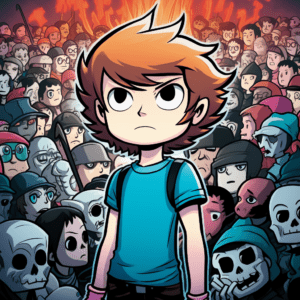Introduction
Scott Pilgrim, a slacker musician and the protagonist of Bryan Lee O’Malley’s iconic graphic novel series “Scott Pilgrim,” faces a series of epic battles against his girlfriend’s seven evil ex-boyfriends. While the story is packed with humor, action, and quirky characters, it also carries significant philosophical implications that delve into themes of self-discovery, personal growth, relationships, and the nature of reality.

The Metaphorical Battle
At first glance, Scott’s journey to defeat seven ex-boyfriends may seem absurd and fantastical, but beneath the surface lies a metaphor for the challenges we all face in our lives. Each evil ex-boyfriend represents a unique personal obstacle, reflecting the inner demons we confront as we navigate relationships, career aspirations, and our own identities.
Self-Identity and Personal Growth
As Scott battles these exes, he must confront not only them but also his own shortcomings and insecurities. The battles force him to introspect, evaluate his past actions, and come to terms with his own flaws. This journey of self-discovery mirrors the philosophical concept of “Know Thyself,” encouraging readers to reflect on their own paths to self-improvement and personal growth.
The Illusion of Control
The battles in “Scott Pilgrim” challenge the notion of control over one’s life. Scott’s encounters often take surreal turns, blending reality and fantasy. This blurring of lines raises questions about the nature of reality and the extent to which we can truly control our circumstances. The battles remind us that life is unpredictable and that we must adapt and evolve to overcome unexpected challenges.
Interconnectedness and Relationships
Scott’s fights with the evil ex-boyfriends highlight the complexity of human relationships. Each ex-boyfriend’s backstory sheds light on the emotional history between characters, emphasizing the interconnectedness of their lives. This serves as a reminder that our actions have ripple effects on others, urging readers to consider the impact of their choices on the people around them.
Embracing Imperfections
The characters in “Scott Pilgrim” are far from perfect, and that imperfection is celebrated throughout the story. Scott himself is flawed, yet his journey is one of redemption and acceptance. This theme encourages readers to embrace their own imperfections and recognize that growth comes from acknowledging and learning from mistakes.
Here’s a brief description of each evil ex-boyfriend’s situation that Scott Pilgrim faces in the series:
- Matthew Patel (#1): Matthew is the first evil ex-boyfriend. He’s gained mystical powers and is now a self-proclaimed “Demon Hipster Chicks” frontman. His situation reflects the idea of holding onto past identities and embracing superficial trends to fit in.
- Lucas Lee (#2): Lucas is a famous actor and skateboarder. His situation explores the concept of societal expectations and the pressure to maintain an image, even at the cost of authenticity.
- Todd Ingram (#3): Todd is a vegan with telekinetic powers. He’s in a relationship with Ramona Flowers, Scott’s love interest. Todd’s situation delves into the complexities of jealousy, possessiveness, and the hidden issues within relationships.
- Roxanne “Roxy” Richter (#4): Roxy is Ramona’s former college roommate, and she possesses the ability to summon a “mystical” skateboard. Her situation explores themes of hidden pasts, unresolved emotions, and the importance of closure.
- Kyle & Ken Katayanagi (#5 & #6): The Katayanagi twins are wealthy and influential DJs who control their surroundings through music. Their situation touches on the theme of materialism, the seductive allure of power, and the potential loss of one’s identity when consumed by material success.
- Gideon Graves (#7): Gideon is the mastermind behind the League of Evil Exes and is Ramona’s most recent ex-boyfriend. He owns a popular club and uses his charisma to manipulate others. His situation represents the idea of toxic control, emotional manipulation, and the struggle to break free from unhealthy patterns.
Each evil ex-boyfriend’s situation adds a layer of symbolism and depth to the story, reflecting various aspects of human behavior, relationships, and personal growth.
Conclusion
“Scott Pilgrim vs. The World” is not just a story of epic battles against evil exes; it’s a reflection of the human experience. Through its humorous and action-packed narrative, it explores profound philosophical themes that resonate with readers. The battles serve as allegories for life’s challenges, personal growth, and the intricate web of relationships we navigate.
#ScottPilgrimPhilosophy #BattleOfSelf #RelationshipRealities #EmbracingImperfections #RealityVsFantasy #MetaphoricalJourney #PersonalGrowth

